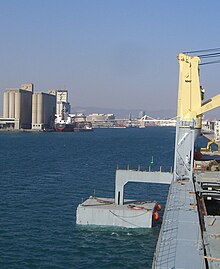pontoon
A pontoon ( French pontoon , from Latin ponto , to pons "bridge") or swimming platform is a floating body that is usually firmly anchored and used as a water level-dependent carrier for various tasks. In contrast to the boat , it is usually transportable, but only partially suitable for driving. Pontoons do not have their own drive and, in contrast to ships without their own drive, usually do not have a streamlined shape. Pontoons are usually closed and air-filled.
use
Pontons are used for floating jetties , as floating islands in bathing lakes , for special rafts , for houseboats and floating houses , for dredgers and floating cranes . As a jetty, pontoons offer a mooring option for ships regardless of the water level. This is particularly advantageous in waters with a tidal range . The jetties in Hamburg consist of pontoons, as do the jetties in many marinas .
Working platform
Pontoons are also used as work platforms. They are of tractors brought to their destination and anchored there. On the pontoon there are all the equipment necessary for the work (tools, cranes, material), sometimes also accommodation for the workers.
In Hamburg, pontoons with wooden sheds are referred to as "Lieger"; they used to serve the Ewer leaders as a workshop, warehouse, office and also living space.
Swim bridge
Another area of application for pontoons are pontoon bridges , which are primarily used for military purposes or as a temporary replacement for destroyed bridges (see multi-purpose pontoon and Bodan ferry ).
Boats
Boats with pontoons as floats are also called pontoon boats .
Floating stage
Pontons are also used for theater stages that float on the surface of the water, such as the floating stage on Lake Lunzer See in Lower Austria .
stabilization
In addition, some heavy lift carriers are equipped with stability pontoons. These pontoons are stored on deck or in the hull of the ship during normal operation. When loading and unloading the cargo, the pontoons, which are attached to the ship with a boom, are lowered to the side, which greatly increases stability. In this way, in cooperation with so-called anti-heeling tanks, the heeling of the ship when taking up large loads can be minimized.
materials
All materials used in shipbuilding are used as materials. Sheet steel and concrete are most commonly used as ballast and reinforcement. Wood , light metal and plastic constructions or several barrels are used for smaller pontoons .
For bathing jetties and boat berths, air-filled, roughly cube-shaped elements made of blown thermoplastic are widespread. They are held together on the vertical edges with bolts on tabs.
See also
- Floating island (natural formation on the water)



